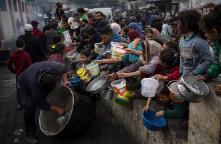
The United Nations Environment Programme (UNEP) said on Wednesday that the number of wildfires globally may grow 14% by 2030 and 50% by the end of the century and called on the international community to focus on preventative rather than response measures.
The finding was made in a report prepared jointly with the GRID-Arendal climate non-profit ahead of the UN Environment Assembly later this month.
The report finds there"s an elevated risk in the Arctic and other regions previously unaffected by fires.
The scientists define extreme fires as extraordinary conflagrations that occur roughly once in a hundred years.
Researchers say that rising temperatures and changes to the way we use land will drive the increase.
The new study calls for a radical reallocation of financial resources from fighting fires to prevention.
The scientists from the UNEP say that large fires that burn for weeks are already becoming hotter and burning longer in many parts of the planet where wildfires have always occurred.
But they are now beginning to flare up in remote northern areas, in drying peatlands and on thawing permafrost.
Climate change and land-use change are projected to make wildfires more frequent and intense, with a global increase of extreme fires of up to 14 percent by 2030, 30 percent by the end of 2050 and 50 percent by the end of the century, compared to the number recorded in 201-2020, the UN agency said.
"The analysis was based on the definition of a catastrophic fire being one that would occur once every 100 years, so it"s a very low frequency fire event," said Dr Andrew Sullivan from the Commonwealth Scientific and Industrial Research Organisation (CSIRO) in Canberra, Australia.
"The result was that the potential for that sort of fire would increase by a factor of 1.3 to 1.5 times, based on global analysis of fire frequency."
The results were similar in a low or high carbon emissions scenario.
The UN agency called on governments to shift their investments from "reaction and response to prevention and preparedness."
"The publication calls on governments to adopt a new "Fire Ready Formula", with two-thirds of spending devoted to planning, prevention, preparedness, and recovery, with one third left for response. Currently, direct responses to wildfires typically receive over half of related expenditures, while planning receives less than one percent," a press release, accompanying the report, read.
Apart from being devastating disasters, wildfires affect the world"s poorest nations, as the restoration of affected areas may lie beyond the means of low-income countries, with waste requiring appropriate disposal.
The study defines extreme conflagrations as fires that are extraordinary or unusual - but this definition can differ markedly depending on your location.
"If you imagine a peat fire in the Arctic, it"s spreading at centimetres an hour. It"s not necessarily a raging inferno, but it"s unusual and spreading over immense areas because there"s no one there to do anything about it," said Dr Sullivan.
"A fire like this in the peatlands is an extreme fire, but it"s not what you would envisage as being an extreme fire if you lived in California."
Even though the study only makes projections on extreme events, the authors believe that lesser incidents of wildfire will also increase as land use changes and populations increase. This could have significant implications for climate change as the extra burning will increase the amount of carbon emitted into the atmosphere.
But the change in frequency will vary depending on a number of local factors. The world is likely to see more fires in Arctic regions because climate change is having such a major impact in the region.
However in Africa, where about two thirds of the world"s wildfires now occur, there are likely to be fewer fires in the coming decades as a growing population is clearing more forest areas for farmland.
"In Africa, the number of fires is decreasing, because of the change in land use and the intensification of agriculture," said Dr Glynis Humphrey from the University of Cape Town.
"Our percentage of area burned is actually decreasing, and our fires are becoming smaller and smaller, because of the reduction in fuel load."
The authors are calling on governments to change their model of spending on large fires.
Right now, the study says that planning and prevention receives less than 1% of funding while firefighting takes over half of the available budget.
Many governments have good intentions in terms of spending more on planning and prevention - but the reality on the ground is different.
"We need to invest more in fire prevention, in full management, also in allowing fires to fulfil their ecological roles," said Prof Paulo Fernandes, from the Universidade de Trás-os-Montes e Alto Douro in Portugal, one of the report"s authors.
"But then, when things get hot, their response will be to deviate from the policy that"s supposed to be in place. In places like California they talk a lot, but then in terms of action, they put the money always in the same place, in firefighting." — Agencies












